|
Post-Season Surprises - II
This feature discusses a journeyman player who had a big impact in a World Series or playoff game.
"I'll never forget the look on (Babe) Adams's face when I told him I wanted him to pitch the opener (of the 1909 World Series)." - Pirates' Player-Manager Fred Clarke
- 27-year-old Charles "Babe" Adams had a fine rookie season in 1909, finishing 12-3 with a 1.11 ERA.
- However, no one considered Babe the ace of a staff that boasted a Big Three of Vic Willis (22-11, 2.24 ERA), Howie Camnitz (25-6, 1.62), and Lefty Leifield (19-8, 2.37).
- Pittsburgh (referred to as "Pittsburg" in the newspapers since the city officially spelled its name that way from 1891-1911) won the pennant by 6.5 games over the Cubs after a 16-game winning streak in early September.
- So it wasn't that Clarke had to use his top starters in the last games to clinch the crown. Camnitz was still recovering from an attack of tonsilitis, but otherwise he could have arranged his starters in any order he wished. But Fred appreciated the fine work his "young giant" Babe had done in the last six weeks of the season, especially his control as Adams issued only 23 free passes in 130 innings.
The Detroit Tigers had grabbed their third straight junior circuit crown.
- They hoped to finally win the "World's Series" (as it was called then) after two straight losses to the Cubs. The Pirates had lost the first Fall Classic in 1903 to the Red Sox.
- The Series would pit two of the greatest players of the era in SS Honus Wagner of the Bucs and Tiger RF Ty Cobb.
So Adams toed the slab to open the best-of-seven series at Forbes Field.
- Perhaps intimidated by the overflow crowd of 29,265, Babe started shakily, surrendering a run in the first inning, but settled down to twirl a six-hit 4-1 victory that was sparked by Clarke's game-tying HR in the fourth.
- Adams retired the side in order in only three innings but repeatedly wiggled out of trouble, stranding eight.
- Babe aided his own cause with two fine fielding plays, grabbing Sam Crawford's high bounder in the first and throwing out the runner at third and making a scoop throw on Donie Bush's bunt in the third to nail him by inches at first.
By the time Babe took the hill again in Game 5, the Series was tied at two games apiece.
- Clarke inexplicably started Camnitz in Game 2, but Howie lasted only 2 1/3 in the 7-2 loss.
- Still not going with Willis or Leifield, Clarke chose Nick Maddox (13-8, 2.21), who surrendered only one earned run in the 8-6 victory at Bennett Park in the Motor City.
- Leifield finally took a turn in Game 4 but gave up all five runs in four innings as the Tigers tied the series 5-0.
|

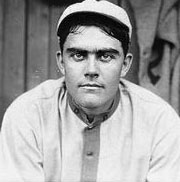
Babe Adams
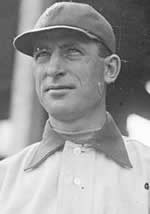
Fred Clarke
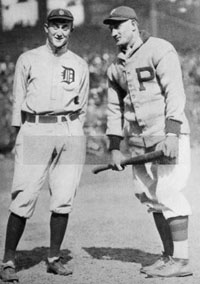
Ty Cobb and Honus Wager at the 1909 World Series
|
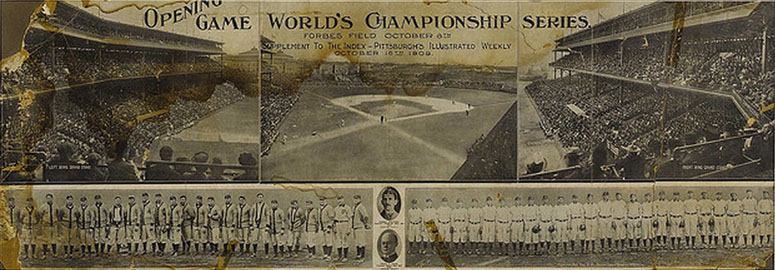
Panorama of Game One of 1909 World Series

Detroit's Bennett Park during the 1909 World Series |
Back home in Pittsburgh October 13, Clarke turned to his Babe.
- Adams responded with a complete game 8-4 triumph. He struck out 8 and walked only 1 on a 40° day with a chilling wind sweeping across the field.
- Detroit's six hits included two homers, two two-baggers, and two singles.
- Clarke's second HR of the series, a three-run clout to deep CF, broke a 3-3 tie in the 7th.
Following an odd 2-2-1-1 format, the Series returned to Detroit for Game 6 on October 14.
Ty Cobb didn't travel with the Tigers from Pittsburgh to Detroit. The reason was that law enforcement authorities in Cleveland had served Michigan Governor Warren with a request to turn Cobb over to them on a charge of assault with intent to kill. Ty had gotten in a fight in a Cleveland hotel with an African-American night watchman. The governor denied the request. So Ty avoided Ohio altogether by taking the longer route through Buffalo and entering Detroit through Windsor, Ontario. After the World Series, Cobb pleaded guilty to assault and battery and paid a $100 fine. He also had to settle a civil suit with the man he attacked.
- Willis finally started but didn't pitch very effectively, allowing 4 runs in 5 innings.
- George Mullin won his second game for the Tigers, 5-4.
The Detroit win forced a Game Seven.
- The National Commission that ruled baseball had determined the site of Game 7 by a coin flip prior to Game 5 that AL President Ban Johnson called correctly.
- They also acceded to Detroit's request to move the game back a day to October 16, a Saturday, in order to boost ticket sales.
- Deacon Phillippe (8-3, 2.32), the 37-year-old veteran who won three games for the Pirates in the '03 Series, begged Clarke to let him pitch Game 7. But the day off gave Fred an opportunity to go with Adams again with only two days rest.
Babe responded with his best game of the Series.
- He shut out the Tigers 8-0 on six hits. He struck out only one but also walked only one. Only in the fourth did Detroit produce more than one hit. No runner went further than second base.
- The crowd was a "distinct disappointment" - 17,562 paid when the game was expected to break all local attendance records. The weather, while far from ideal (50° and blustery), was better than for any of the other three contests in Detroit.
- Adams took home the princely sum of $3,117 for his efforts. Only $1,853 was his World Series share. The rest came from donations by Pirate fans and his teammates, who kicked in $25 each.
So the Pirates won the Classic despite the fact that the Big Three failed to win a game thanks to their first-year hurler.
Babe Adams stat line for the 1909 World Series
| G |
W |
L |
CG |
IP |
H |
R |
ER |
ERA |
HR |
BB |
K |
| 3 |
3 |
0 |
3 |
27 |
18 |
5 |
4 |
1.33 |
2 |
6 |
11 |
The Pirates would not return to the World Series until 1925. Amazingly, Adams pitched in that series at age 43, having toiled for only Pittsburgh except for a year in the Western Association in 1917. He threw one scoreless inning.
Babe's career stats show tht he has more wins and shutouts than Dizzy Dean and Sandy Koufax. Yet he seems to have gotten no consideration for the Hall of Fame.
References: The Biographical Encyclopedia of Baseball (2000);
The Seventh Game, Barry Levenson (2004)
|
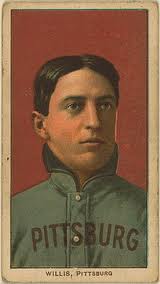
Vic Willis
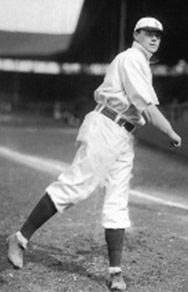
George Mullin
|
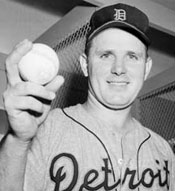
Virgil Trucks
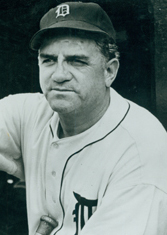
Steve O'Neill
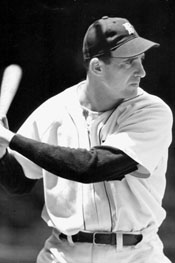
Hank Greenberg
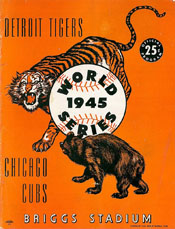

|
Virgil Trucks joined the Detroit pitching staff for the 1942 season after an eye-popping minor league career.
- 1938 Class D Andalusia (AL): 25-6, 1.25 ERA
- 1939 Class D Alexandria (LA) and A1 Beaumont: 16-10, 2.82 ERA
- His fast ball earned him the obvious nickname of "Fire" Trucks. But control limited his advance - 125 BB in '38, 114 in '39.
- He finally put it together at Buffalo of the AA International League in 1941 when he struck out 204 in 204 innings and walked only 76.
Trucks spent the 1942 and 1943 seasons with the Tigers.
- He went 14-8 in '42 with a 2.74 ERA.
- His 1943 slate read 16-10, 2.84.
Virgil joined the Navy in February 1944.
- After training at Great Lakes Naval Station in Chicago, he went to the Pacific Theatre at the end of the year and played in the Army-Navy Service World Series in Hawaii, winning both Game 1 and Game 4 of the series.
- Trucks later played for the Fifth Fleet team before being stationed on Guam. A knee injury on that island brought him stateside to Oklahoma.
- He was scheduled for discharge in July 1945, but his papers sat on an officer's desk until September as the Tigers battled the Washington Senators for the pennant.
- In the meantime, Trucks found a catcher who could handle his fastball and began training for baseball in dungarees and spikes.
The Navy finally gave Trucks his medical release on September 27.
- The next day, under special regulations governing newly-furloughed players, the commissioner's office placed Virgil on the eligible list for the World Series.
- In a quirk of scheduling, the Senators finished their season on Sunday, September 23. They stood only one game behind the Tigers, who still had four games to play.
- Detroit split a doubleheader with Cleveland on Wednesday to remain one up. They headed to St. Louis for two with the Browns over the weekend.
Virgil went from Oklahoma to St. Louis ahead of the time to work with C Paul Richards, who would make a report to manager Steve O'Neill.
O'Neill told the press on Friday: Paul called today to say that Trucks checked in at 190 pounds, five poounds under his 1943 playing weight and is in top shape. If he's ready to pitch, he'll work Saturday. Otherwise, we'll use Stubby Overmire. Then it'll be Trucks or Paul Trout Sunday. With that order, we'll have our best lefthander, [Hal] Newhouser, to go against Washington Monday if it comes down to that [a playoff] - but, believe me, I hope it doesn't.
The weather threw a monkey wrench into O'Neill's plans.
- A cold, beating rain forced postponement of Saturday's game.
- So a doubleheader was scheduled for Sunday with the Tigers having to win one to clinch the pennant.
Trucks started the first game of the twinbill.
- He pitched well, allowing only three hits through 5 1/3 innings with 3 Ks and 2 BBs.
- With the Tigers leading 2-1, Steve decided to go with his ace, Newhouser, to close out the game.
- But the Browns pushed across runs in the 7th and 8th to take a 3-2 lead into the ninth.
- That's when LF Hank Greenberg, who had played 78 games after leaving the service himself, walloped a grand slam for a 6-3 victory.
- With the pennant clinched and darkness setting in, the meaningless second games was cancelled.
Impressed with Virgil's performance in St. Louis, O'Neill started him in the second game of the Series after the Cubs shellacked Newhouser 9-0 in the opener.
- Old-timer Rabbit Maranville expected Virgil to do well. Trucks throws that low ball the Cubs don't like. I wouldn't be surprised if Trucks is the only Tiger pitcher who can beat the Cubs.
- Whether it was the low ball or not, Fire pitched a masterful 7-hitter to even the series, 4-1.
- His complete game gave the Tiger bullpen a chance to rest after four hurlers took the mound in Game One.
Virgil toed the slab again for Game 6 at Wrigley Field with the Tigers leading 3-to-2 in games.
- After shutting down Chicago for four innings, the fireballer ran into trouble in the 5th.
- Four singles and a walk drove him from the hill as the Cubs took a 4-1 lead.
- But the Tigers rallied and tied the game at 7 in the 8th.
- Chicago stayed alive with a run in the 12th.
As any baseball fan knows, the victory only postponed the agony for Cubs fans as the Tigers scored 5 in the first against Hank Borowy, who had beaten them twice, to cop the Series 9-3.
Detroit couldn't have done it without Trucks' victory in Game Two. He would always call that triumph his greatest thrill in baseball, even better than his two no-hitters in 1952.
|
Al Gionfriddo and Sandy Amoros
These two outfielders will always be linked in Brooklyn Dodgers lore.
- Short of stature (with Amoros an inch taller at 5' 7"), each batted and threw lefthanded.
- Both leaped from obscurity to national fame with sensational catches in LF in Yankee Stadium in key World Series games.
- Neither did anything exceptional after their crucial Fall Classic feats.
Dysart PA native Al Gionfriddo came to the Dodgers in May, 1947 in a trade with the Pittsburgh Pirates.
- Benefitting from the paucity of talent in 1945, the last year of World War II, Al played in 122 games for the Pirates, hitting a respectable .284.
- When the service veterans returned for the '46 season, Gionfriddo mostly sat on the bench. He played in 64 games that year, making only 116 plate appearances.
- Al had no power but his rabbit-like speed made him an excellent outfielder.
- He appeared in only one contest for the Bucs before becoming a throw-in to complete the deal in which Pittsburgh paid the Dodgers $100,000 for five players: P Hank Behrman, Cal McLish, and Kirby Higbe, C Dixie Howell, and IF Gene Mauch.
- Gionfriddo appeared in just 37 games for Brooklyn the rest of the '47 season, making 81 plate appearances as the Dodgers swept to the pennant by five games.
No one would have predicted that the bench warmer would have a significant impact on two World Series contests with the hated Yankees.
- Game 2: Al pinch-hit for P Rex Barney and grounded out to end the 10-3 Yankee victory.
- Game 4: Manager Burt Shotton sent Gionfriddo out to run for Carl Furillo with two outs in the bottom of the 9th. The Dodgers trailed 2-1, and Yankee P Bill Bevens had yet to yield a hit. When Al stole 2nd, NY manager Bucky Harris decided to walk Pete Reiser to put the potential winning run on 1st. The move backfired as PH Cookie Lavagetto doubled off the RF wall, scoring Gionfriddo with the tying run and PR Eddie Miksis with the winning run.
- Game 5: With the Dodgers trailing 2-0, Al led off the bottom of the 6th by pinch-hitting for P Joe Hatten against Spec Shea. He drew a walk and, after a strikeout, moved to 2nd when Shea passed Pee Wee Reese. Jackie Robinson's single to CF scored Gionfriddo with what would turn out to be Brooklyn's only run of the afternoon.
- Game 6: This is the game that etched Gionfriddo's name in baseball history. With the Dodgers leading 8-5 and needing a win to force Game 7, Shotton sent Gionfriddo to LF in the bottom of the 6th. It proved to be one of the greatest defensive substitutions in World Series history. With two out and men on 1st and 2nd, Joe DiMaggio stepped to the plate and smashed Joe Hatten's second pitch deep into LCF. Al took off with the crack of the bat and raced to the 415' mark where he reached up and speared the ball just before it would have cleared the low bullpen fence. One of the most famous film snippets in baseball history shows the stoic DiMaggio kicking the dirt in disgust as he approached 2B.
Broadcaster Red Barber's call of Gionfriddo's catch is one of radio's most memorable: Gionfriddo, back, back, back, back ... he makes a onehanded catch against the bullpen. Oh, doctor!
- The Dodgers held on to win 8-6. However, the Yankees denied Brooklyn its first World Series championship the next day, 5-2.
- Gionfriddo, like Game 4 protagonists Lavagetto and Bevens, never played another game in the major leagues.
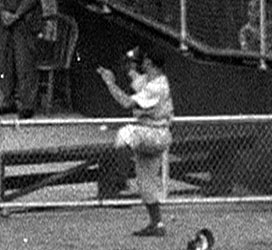 
Fast forward eight years to 1955.
- Havana-born Edmundo "Sandy" Amoros appeared in 119 games during his first full season with the Dodgers. He hit .247 with 10 HRs.
- The finest Brooklyn team ever - and one of the greatest in ML history - opened the season with ten straight wins and never looked back. Their nearest pursuer, the Milwaukee Braves, finished a distant 13.5 games behind.
After making a brief appearance in one game of the 1952 Series, Amoros played in four games of the '55 Classic.
- Game 3: Starting in LF, Sandy had a perfect day at the plate: hit by pitch and a run scored, intentional walk, base on balls, and a single that drove in a run.
- Game 4: Amoros had a single and a walk and scored a run.
- Game 5: He smacked a two-run homer off Bob Grim in the 2nd inning but struck out his other three at-bats.
- Game 6: Another 1-for-4 day, during which he began in LF but moved to CF in the 4th. Sandy struck out against Whitey Ford to end the 5-1 New York victory.
With southpaw Tommy Byrne taking the mound for the Yankees in Game 7, Dodger manager Walt Alston kept Sandy on the bench with Junior Gilliam in LF.
- When George Shuba pinch-hit for 2B Don Zimmer in the top of the 6th, Alston moved Gilliam to 2nd and inserted Amoros into LF in the bottom of the inning. The skipper could have put Shuba in LF and saved Sandy for later. But his move proved to be prescient.
- Bill Martin led off the Yankee 6th with a walk. Then Gil McDougald beat out a bunt.
- That brought Yogi Berra to the plate with the tying runs on base. At that point, the Yankee C was hitting .454 for the Series, with 10 hits - the most of any participant - in 22 ABs.
- Yogi sliced a liner down the LF line that looked for sure like an extra base hit. The only question was whether it would stay fair. Amoros, who was left-handed, raced over and speared the ball a few feet inside the foul line. Sandy then threw to SS Pee Wee Reese who relayed the ball to 1B Gil Hodges just in time to double up McDougald, who had assumed the ball would drop. All observers agree that Gilliam, being right-handed, would not have caught the ball, resulting in a two-run double to tie the game and putting the go-ahead run on 2nd with none out.
- P Johnny Podres went on to shut out the Yankees 2-0 to bring the first championship to Flatbush.
- While Willie Mays' catch in Game One of the 1954 Series is regarded as the greatest in World Series history, Amoros's play should appear in any Top Five list along with Gionfriddo's.
|
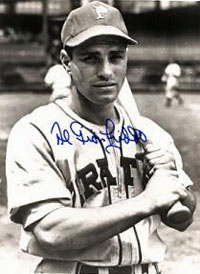
Al Gionfriddo

Cookie Lavagetto
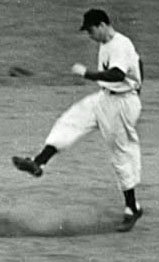
Joe DiMaggio shows frustration after Gionfriddo's catch.
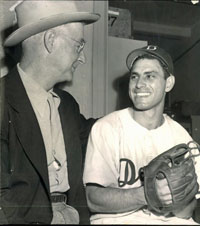
Burt Shotton and Gionfriddo after Game 6
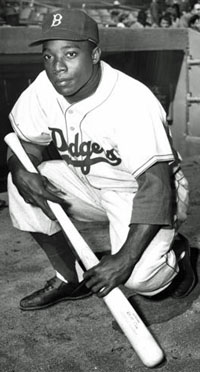
Sandy Amoros
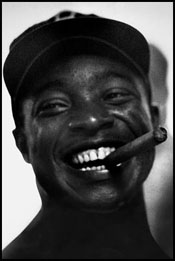
Sandy Amoros after Game 7
|
Amoros continued with the Dodgers in 1956 and '57 before spending 1958 at AAA Montreal.
- He played at Montreal again in '59 before appearing in five games with the Los Angeles Dodgers at the end of the season.
- After starting the '60 campaign with Los Angeles, Sandy finished the season and his career in the AL with Detroit.
|

Bob Kuzava
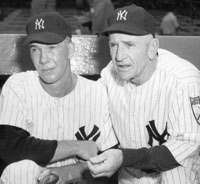
Bob Kuzava and Casey Stengel

Johnny Sain
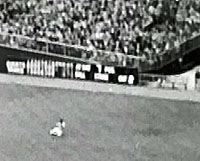
Hank Bauer makes the final out.
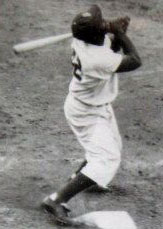
Jackie Robinson watches his pop up over the mound.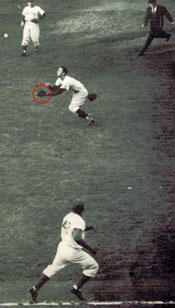
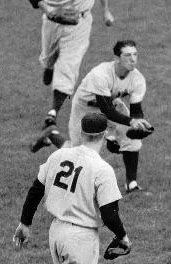
Billy Martin catches Robinson's pop up.
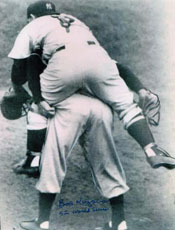
Berra jumps on Kuzava's back after the last out.
|
Southpaw Bob Kuzava from Wyandotte MI was at best a journeyman P during his MLB career, which spanned 12 seasons with eight different teams. But in back-to-back World Series, he provided clutch relief work that helped the Yankees add two more World Series titles to their trophy case.
- Kuzava's final MLB line: W 49, L 44, 4.05 ERA, 34 complete games in 99 starts, 13 saves
- But he provides yet another example of manager Casey Stengel's ability to add a player to his roster that fills a specific role.
- Bob came to the Yankees in a June 15, 1951, trade with the Washington Senators, who received three pitchers - Tom Ferrick, Bob Porterfield, and Fred Sanford.
- Kuzava appeared in 23 games for Stengel the rest of that season, finishing 13. He compiled five saves - a stat, of course, that has been retroactively calculated. His ERA for the Bronx Bombers was 2.40. He won eight games in relief during the stretch run to NY's third straight pennant, allowing only three runs in his last 26 innings.
The Yanks' opponent in the Fall Classic was the New York Giants, fresh off their electrifying victory over the Dodgers in the three-game NL playoff on Bobby Thomson's "Shot Heard 'Round the World."
- Kuzava saw no action in the series until Game Six. Ahead three games to two, the Yankees led 4-1 going into the 9th at Yankee Stadium.
- Another late-season acquisition, Johnny Sain, had shut out the Giants in the 7th and 8th but faltered in the 9th. Three straight singles loaded the bases with no outs.
- Despite the fact that two righthanded batters, Monte Irvin and Thomson, were due up, Stengel signaled for Kuzava because he knew that Bob would not walk anyone.
- Needing one more hit to tie the all-time Series record of 12, Irvin socked a high fly to LCF. Gene Woodling hauled it in 400' from home plate. Eddie Stanky, the runner on 3rd, scored easily. Al Dark on 2nd and Whitey Lockman on 1st tagged and scooted to 3rd and 2nd.
- With 1st base open, Stengel decided not to walk Thomson. Bobby also swung at the first delivery and sent it soaring to LF. Again Woodling caught it against the fence. Dark trotted home while Lockman held second.
- With the lead whittled down to 4-3, Giants manager Leo Durocher sent up another righthanded hitter, Sal Yvars, batting in place of lefthanded RF Hank Thompson. The backup C had appeared in only 25 games all season but hit .317.
- Stengel went to the mound and asked Kuzava, "You know this guy?" "Yeah," said Bob. "I know him from the minors." That was all Casey needed to hear. So he returned to the dugout. Meanwhile, the southpaw turned and motioned his outfielders to play Yvars straightaway.
- Kuzava threw an outside fast ball that Yvars liked. Sal slashed a liner toward RF as Lockman started running from 2nd with two outs. Playing shallow and in a direct line with the path of the ball, RF Hank Bauer took off with the crack of the bat as the ball faded slightly away from him toward the foul line. He lost it in the shadows for a moment before relocating the horsehide. He lunged forward, falling to his knees, and speared the ball to save the Series. Afterwards, the former Marine sergeant explained, "I thought for a while I wouldn't make it. ... I knew I couldn't let that one get past me and it didn't."
- The three pitches that Kuzava had thrown for outs resulted in drives that traveled over 1200' but were caught.
- "I felt nervous at first because it was my first World Series," admitted Bob. "But after I threw a few I knew I was okay. I threw one curve and the rest fast balls."
- Yankee pitching coach Jim Turner added, "We had a lot of confidence in Bob. You know, he only gave up two earned runs in relief throughout the season."
Kuzava had another solid year for the Yankees in 1952.
- He started 12 games and appeared in 16 others in relief. He finished nine contests, recording three saves. His ERA rose to 3.45 as he won 8 and lost 8.
- Once again, Bob didn't appear in the World Series until the final game, Game 7 at Ebbets Field. This time, Casey didn't wait until the 9th to call on his lefty.
- Kuzava's big moment came in the bottom of the 7th. The Yankees led 4-2 thanks to two circuit clouts by 20-year-old Mickey Mantle, who had replaced the immortal Joe DiMaggio in CF when Joltin' Joe retired after the '51 World Series.
- Despite having worked 7 2/3 innings the day before, Vic Raschi took the mound to hold the lead but, similar to Sain the year before, ran into trouble right away. Carl Furillo walked. After Rocky Nelson popped out, Billy Cox singled to short RF, Furillo taking 2nd. When Raschi handed Pee Wee Reese a free pass to load the bases, Stengel brought in Kuzava in exactly the same situation Bob had faced against the Giants the year before - bases loaded and one out. The lefty later admitted that he said to himself, "This guy (Stengel) has got to be crazy to bring me in here."
- This time, Bob faced a lefthanded hitter, Duke Snider, Brooklyn's leading hitter in the Series. However, Kuzava felt confident because he had handled Snider in the International League. The Dodger CF worked the count full before weakly popping up a rising fastball to Gil McDougald at 3B.
- Up came Jackie Robinson. Kuzava assumed his manager would replace him with Sain, a righthander who had battled Jackie many times in the NL. Casey took a few steps toward the mound, then sat back down. His gut told him to stick with Kuzava.
Even C Yogi Berra was testy, arguing the call that made the count 2-1. Jackie hit two straight fouls, ratcheting up the suspense even more. Then Robinson reached out for a curve and hit a little popup over the mound that the wind blew back toward the plate. Kuzava could have made the catch with ease, but this was the major leagues. Pitchers don't go after pop flies. Instead, he called "Joe, Joe" to get 1B Joe Collins to take it. But the 1B had lost the ball in the glare pouring through the openings behind the 3B stands. With the runner on 3B already across the plate and the one from 2B on his way home, it looked for a moment that the ball would drop and give the Dodgers the lead and perhaps the Series. That's when 2B Billy Martin, seeing what was going on, charged in from 2B, his cap flying off, to grab the ball at knee level just behind the mound.
Showing the best stuff of any Yankee hurler of the afternoon with his fastball really hopping as Berra said after the game, Kuzava had wiggled out of the jam to keep the score 4-2.
- With his mates unable to extend the lead, Bob faced the Dodgers in the bottom of the 8th. Roy Campanella struck out swinging. That brought up 1B Gil Hodges, who had failed to get a hit in 20 ABs in the Series. His ignominious performance continued with a grounder to McDougald, whose throw to 1B pulled Collins off the bag. Unfazed by the error, Kuzava fanned Andy Pafko, who tipped the 3-2 delivery into Berra's mitt. Furillo brought a roar from the crowd with a line drive to LF, but Woodling caught it right in front of the warning track.
- Stengel let Kuzava hit for himself in the top of the 9th. He bounced out. McDougald singled but was stranded. So Bob took the hill with the two-run lead. Bob Morgan, the first of three straight righty batters, flew to Woodling. Bobby Cox stepped in looking for his third hit of the day. Instead, he hit an 0-2 curve to Martin, who threw to 1B for the easy out. Reese came up looking to prolong the inning and bring Snider to the plate. Stengel yelled to his boys to watch out for the bunt. Kuzava gave the Brooklyn fans some hope with two straight balls before popping a fast one down the middle. Reese stepped out to slow down the big lefty. A curve caught the inside corner to even the count. A foul back kept Pee Wee alive. Another foul as the ball hit the handle of the bat. Finally, Reese flied to LF to clinch the Yankees' fourth straight championship.
So journeyman Bob Kuzava had recorded the final outs of two straight World Series, working out of bases loaded jams in both cases.
- Stengel summarized his closer's performance like this. That fella (Kuzava) came in there and really took me out of a jam. That boy hadn't been pitching hardly any all season, but he really went in there and threw hard.
- Casey found Kuzava with his shirt off, tossed his arms around the P, and gave forth a typical Stengel grin as the flash bulbs popped. Bob said he was lucky that Snider popped out with the bases loaded in the 7th. I fed him a fast one straight down the middle on the 3 and 2 pitch. I was lucky that he got just a piece of the ball.
- Dodger manager Charlie Dressen: That Kuzava was burning his fast ball in there. He was very quick.
Kuzava also made one appearance in the 1953 World Series but without the drama of his previous two showings. He hurled 2/3 of an inning against Brooklyn, giving up two hits and one run.
|
|
Ken Boswell - 1969 and 1973 World Series
The New York Mets made the World Series in both 1969 and 1973, and Ken Boswell played a key role in both postseasons.
- Boswell spent eight years with the Mets, starting in 1967. He posted a composite average of .250 with 31 home runs.
- He served as a utility player, used mostly at 2B but sometimes at 3B.
The '69 Mets had to win the first NL Championship Series after the league was split into East and West divisions with the addition of two expansion clubs, the Montreal Expos and the San Diego Padres.
- Starting in all three games of the Mets' sweep of the heavily-favored NL West Champion Atlanta Braves, Boswell batted .333 (4-for-12), clouted 2 HRs, and drove in five runs.
- A left-handed batter, Ken started Game One against the Braves' righthanded knuckleballer Phil Niekro. Although he didn't get a hit, Boswell did draw a walk and scored two runs in the 9-5 victory.
- In Game Two, he got only one hit but it was a big one - a two-run HR off Milt Pappas. New York outlasted the Braves in another slugfest, 11-6.
- Ken saved his best performance for Game Three at Shea Stadium. He came up in the bottom of the 4th with Art Shamsky on 1st and clouted a Pat Jarvis pitch out of the park to give the Mets a 3-2 lead. Then he smacked a single off George Stone in the 5th to score Cleon Jones to increase the Mets' lead to 6-4 on their way to a 7-4 victory.
- His five RBIs led the Mets, and his two roundtrippers tied him with Tommie Agee for tops on the club in the NLCS.
Despite his impressive performance in the NLCS, Boswell played in only one game of the World Series against the Baltimore Orioles.
- Manager Gil Hodges benched Ken in favor of Al Weis against southpaws Mike Cuellar and Dave McNally, each of whom started two of the five games.
- But Ken contributed in Game Three against righthander Jim Palmer. He led off the bottom of the 6th by beating out an infield hit and later scored on Jerry Grote's double to extend the Mets' lead to 4-0.
- The Miracle Mets astounded the baseball world by capturing the Fall Classic in five games.
Four years later, the Mets won the NL pennant again, this time under Manager Yogi Berra.
- Throughout the season, Yogi played Felix Millan, a better fielder than Boswell, at 2B. Ken appeared in 76 games, batting just .227 with two HRs and 14 RBIs.
- In the Mets' seven-game upset of the Cincinnati Reds in the NLCS, Ken pinch-hit once.
- But in the World Series against Oakland, which also lasted seven games, Boswell batted 1.000 in three pinch-hit appearances.
- In Game One, a 2-1 A's victory, Ken hit for P Jon Matlack to open the top of the 7th against Rollie Fingers and singled to RF. However, he was erased when the next batter, Wayne Garrett, bounced into a DP.
- Ken "rode the pine" for Game 2 and all three games at Shea Stadium as the Mets took a three games-to-two lead back to Oakland. However, Yogi sent him up as a pinch hitter again in Game 6. The Mets trailed 2-0 to Catfish Hunter in the top of the 8th when Ken stepped in for P Tom Seaver with one out and no one on base. He rapped a single to RF and scored on singles by Wayne Garrett and Millan off reliever Darold Knowles to cut the lead to 2-1. However, the A's held on, scoring an insurance run in the 8th to force a Game 7.
- The next day, the Athletics jumped on Jon Matlack early and led 5-1 in the top of the 7th when Boswell hit for P Ray Sadecki against Fingers with two outs. Once again, Ken singled, this time to CF, but was stranded when Wayne Garrett looked at strike three. The A's won 5-2 to win the second of their three consecutive World Series titles.
So Boswell's postseason log looks like this.
8 games, 8-for-19, .421, six runs scored, five RBIs, two HRs.
Not bad for a journeyman infielder.
|

Ken Boswell
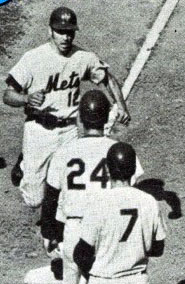
Boswell greeted after homering in 1969 NLCS Game 2
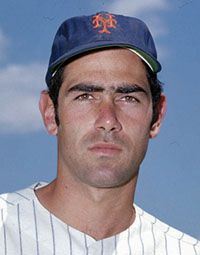
Art Shamsky

Yogi Berra
|
|